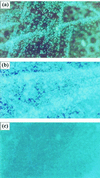Biofilm formation by the fungal pathogen Candida albicans: development, architecture, and drug resistance
- PMID: 11514524
- PMCID: PMC95423
- DOI: 10.1128/JB.183.18.5385-5394.2001
Biofilm formation by the fungal pathogen Candida albicans: development, architecture, and drug resistance
Abstract
Biofilms are a protected niche for microorganisms, where they are safe from antibiotic treatment and can create a source of persistent infection. Using two clinically relevant Candida albicans biofilm models formed on bioprosthetic materials, we demonstrated that biofilm formation proceeds through three distinct developmental phases. These growth phases transform adherent blastospores to well-defined cellular communities encased in a polysaccharide matrix. Fluorescence and confocal scanning laser microscopy revealed that C. albicans biofilms have a highly heterogeneous architecture composed of cellular and noncellular elements. In both models, antifungal resistance of biofilm-grown cells increased in conjunction with biofilm formation. The expression of agglutinin-like (ALS) genes, which encode a family of proteins implicated in adhesion to host surfaces, was differentially regulated between planktonic and biofilm-grown cells. The ability of C. albicans to form biofilms contrasts sharply with that of Saccharomyces cerevisiae, which adhered to bioprosthetic surfaces but failed to form a mature biofilm. The studies described here form the basis for investigations into the molecular mechanisms of Candida biofilm biology and antifungal resistance and provide the means to design novel therapies for biofilm-based infections.
Figures







References
-
- Albani J R, Plancke Y D. Interaction between calcofluor white and carbohydrates of alpha 1-acid glycoprotein. Carbohydr Res. 1999;318:194–200. - PubMed
-
- Anaissie E J, Rex J H, Uzun O, Vartivarian S. Predictors of adverse outcome in cancer patients with candidemia. Am J Med. 1998;104:238–245. - PubMed
-
- Austin J W, Bergeron G. Development of bacterial biofilms in dairy processing lines. J Dairy Res. 1995;62:509–519. - PubMed
-
- Bagge N, Ciofu O, Skovgaard L T, Hoiby N. Rapid development in vitro and in vivo of resistance to ceftazidime in biofilm-growing Pseudomonas aeruginosa due to chromosomal β-lactamase. APMIS. 2000;108:589–600. - PubMed
-
- Baillie G S, Douglas L J. Candida biofilms and their susceptibility to antifungal agents. Methods Enzymol. 1999;310:644–656. - PubMed
Publication types
MeSH terms
Substances
Grants and funding
LinkOut - more resources
Full Text Sources
Other Literature Sources
Medical
Molecular Biology Databases
Miscellaneous

